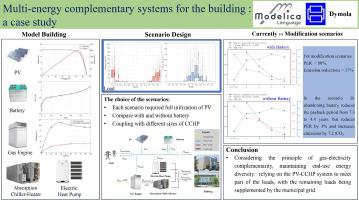当前位置:
X-MOL 学术
›
Energy Convers. Manag.
›
论文详情
Our official English website, www.x-mol.net, welcomes your feedback! (Note: you will need to create a separate account there.)
A case study of multi-energy complementary systems for the building based on Modelica simulations
Energy Conversion and Management ( IF 10.4 ) Pub Date : 2024-03-11 , DOI: 10.1016/j.enconman.2024.118290 Cong Wu , Zhiguang Chen , Yiming Zhang , Jianguo Feng , Yitong Xie , Chaokui Qin
Energy Conversion and Management ( IF 10.4 ) Pub Date : 2024-03-11 , DOI: 10.1016/j.enconman.2024.118290 Cong Wu , Zhiguang Chen , Yiming Zhang , Jianguo Feng , Yitong Xie , Chaokui Qin

|
The utilization of renewable energy sources and the development of energy storage technologies have enhanced the interconversion of various energy sources to slow down global warming. The building sector, as the main bearer of energy consumption, is essential for its energy saving and emission reduction. Integrating natural gas-based combined cooling, heating, and power systems with renewable energy generation facilities is an effective solution. For that, different scenarios are designed to provide energy for a specific office building and compared with the current scenario of depending only on the municipal grid. Equipment models for photovoltaic, battery, gas engine, absorption chiller-heater, and electric heat pump are created. The results show that the multi-energy complementary system has better economic and environmental characteristics, with a primary energy ratio of over 80 % and emission reduction of over 17 %; the advantages of configuring the unit capacity to meet the cooling and heating loads for 80 % of the year are obvious, and in this scenario abandoning battery storage has higher economics for users, with a static payback period from 7.3 years to 4.4 years, but the primary energy ratio decreased by 3 % and carbon emissions increased by 7.2 tCO. It is recommended to consider the principle of gas-electricity complementarity, relying on the combined cooling, heating, and power system to meet part of the loads, with the remaining loads being supplemented by the municipal grid. The installation of batteries should be considered comprehensively based on the price of the batteries and the requirement for energy-saving and emission-reduction.
中文翻译:

基于Modelica模拟的建筑多能互补系统案例研究
可再生能源的利用和储能技术的发展增强了各种能源的相互转换,以减缓全球变暖。建筑行业作为能源消耗的主要承载体,节能减排至关重要。将基于天然气的冷热电联供系统与可再生能源发电设施集成是一种有效的解决方案。为此,设计了不同的场景来为特定的办公楼提供能源,并与目前仅依赖市政电网的场景进行比较。创建了光伏、电池、燃气机、吸收式冷暖机、电热泵等设备模型。结果表明,多能互补系统具有较好的经济性和环境特性,一次能源比例超过80%,减排17%以上;配置单位容量满足全年80%的冷热负荷的优势是显而易见的,在这种场景下放弃电池存储对于用户来说具有更高的经济性,静态投资回收期为7.3年至4.4年,但一次能源占比下降3%,碳排放增加7.2吨CO2。建议考虑气电互补原则,依靠冷热电联供系统满足部分负荷,剩余负荷由市政电网补充。电池的安装应根据电池的价格和节能减排的要求综合考虑。
更新日期:2024-03-11
中文翻译:

基于Modelica模拟的建筑多能互补系统案例研究
可再生能源的利用和储能技术的发展增强了各种能源的相互转换,以减缓全球变暖。建筑行业作为能源消耗的主要承载体,节能减排至关重要。将基于天然气的冷热电联供系统与可再生能源发电设施集成是一种有效的解决方案。为此,设计了不同的场景来为特定的办公楼提供能源,并与目前仅依赖市政电网的场景进行比较。创建了光伏、电池、燃气机、吸收式冷暖机、电热泵等设备模型。结果表明,多能互补系统具有较好的经济性和环境特性,一次能源比例超过80%,减排17%以上;配置单位容量满足全年80%的冷热负荷的优势是显而易见的,在这种场景下放弃电池存储对于用户来说具有更高的经济性,静态投资回收期为7.3年至4.4年,但一次能源占比下降3%,碳排放增加7.2吨CO2。建议考虑气电互补原则,依靠冷热电联供系统满足部分负荷,剩余负荷由市政电网补充。电池的安装应根据电池的价格和节能减排的要求综合考虑。



























 京公网安备 11010802027423号
京公网安备 11010802027423号